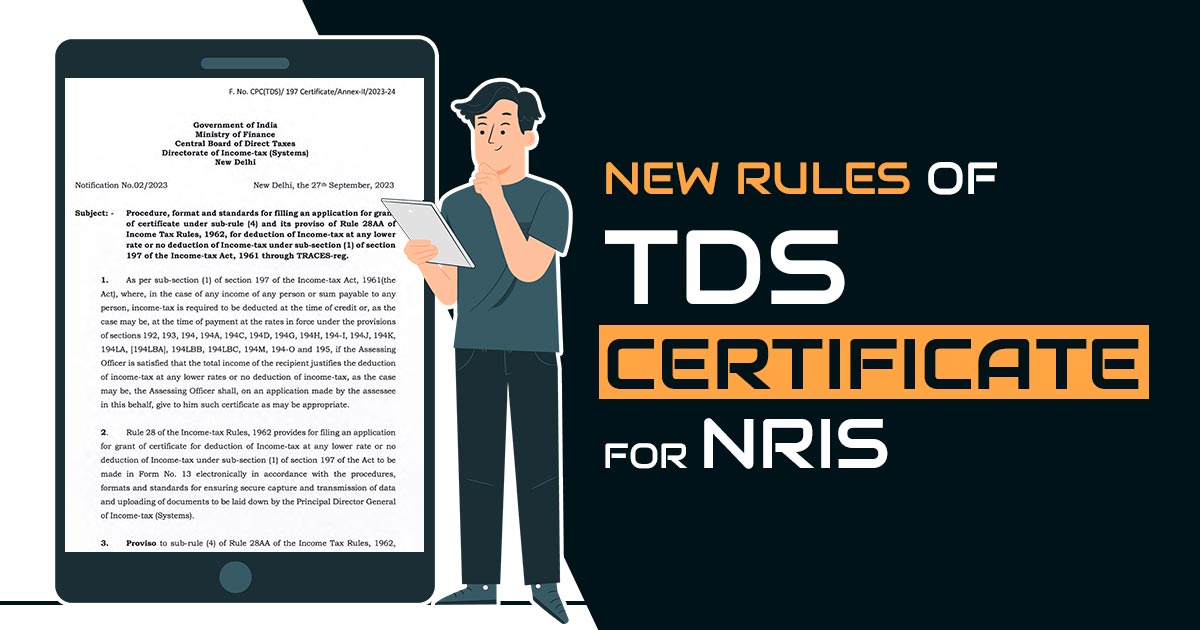
Non-resident Indians (NRIs) need to get a Tax Deduction at Source (TDS) certificate to avoid having taxes deducted on income generated in India. NRIs cannot utilise Form 15G/H to excuse themselves from TDS on their income, as residents may. Instead, they must submit an application to the assessing officer to get a certificate that either lowers or completely removes the tax deduction rate.
The procedure, rules, and format for acquiring these TDS certificates have recently been updated by the Central Board of Direct Taxes (CBDT), which published a circular on September 27, 2023. Although there have been modifications to how NRIs apply for the lower or nil TDS certificate, tax experts have remarked that the new standards are very similar to the previous ones.
What Has Changed in the Application Process for Lower or Nil TDS for NRIs?
One significant alteration in the NRI lower or nil TDS application process involves the removal of various verification methods for applications submitted to the assessing officer. Tax expert mentioned that “E-verification options like Aadhar OTP, mobile OTP, etc., for Form 13 are no longer available on the TRACES NRI website (www.nriservices.tdscpc.gov.in). The only method for verification on the TRACES NRI website is the Digital Signature Certificate (DSC).”
NRIs wishing to get a NIL or reduced TDS certificate must fill out Form 13 online. After submitting the form, they must check it. A Digital Signature Certificate (DSC) will now be the accepted verification technique. The evaluating officer will continue processing after receiving the verified form.
There are no other significant changes that affect NRIs in this situation other than the elimination of extra verification procedures for Form 13 applications.
What Occurs Following the Submission of Form 13 to Request a Reduced or Zero TDS Rate?
Once an NRI has submitted an online application via Form 13 seeking a lower or nil TDS rate, the TDS assessing officer (AO) will carefully examine the explanations and justifications presented by the applicant. Subsequently, the AO will evaluate the TDS rate recommended by the income tax department’s software. This rate may either be reduced, set to zero, or left unaltered. If both the computer system and the AO concur that the existing TDS rate is appropriate, the Form 13 application will be denied.
If the TDS assessing officer (AO) grants approval for a reduced or zero TDS rate, a certificate will be issued that specifies the precise TDS rate, the applicable time frame, and the Tax Deduction and Collection Account Number (TAN), along with other details of the deductor (the entity responsible for making the payment). In cases where the AO decides on a TDS rate different from the one suggested by the income tax department’s software, an explanation for this choice is mandatory.
The TAN of the deductor is required when applying a lower or zero TDS rate through the e-filing income tax return (ITR) portal. As a result, if the TDS AO approves a reduced or zero TDS certificate, it will be associated with the designated deductor and include a validity term. As a result, not every deductor for the individual can use the same TDS certificate. The aforementioned deductor is the only one for whom the TDS certificate is issued.
Read Also: How to Generate Form 16B Certificate Via Gen TDS Software
The AO’s certificate for reduced or nil TDS is valid for one fiscal year or for usage in a single transaction. To demonstrate this, think of the following example from Tanna: The certificate only pertains to the specific transaction for which an NRI is selling their property and requesting a reduced or zero TDS deduction. A reduced or zero TDS certificate can also be requested if an NRI is renting out an Indian flat, but its validity only lasts through March 31—the end of the financial year.
Which Types of Income Require NRIs to Provide TDS Certificates?
Non-resident Indians (NRIs) who make money in India must pay tax at the source (TDS). This consists of the income from rent, interest from bank accounts, fixed deposits, and dividends from stocks and mutual funds, among other sources of income. Therefore, before crediting the income or at the time it accrues, whichever occurs first, persons or corporations making payments to NRIs must deduct the relevant tax.
What’s the Recent Change in the Nil TDS Application Process for Indian Residents?
Regarding Indian residents, recent circulars have introduced additional verification methods. According to Mihir Tanna, “Previously, the verification process for Form 13, used to obtain lower or nil TDS certificates, was limited to Digital Signature Certificate (DSC) or Electronic Verification Code (EVC). However, the income tax department has now incorporated Aadhaar and mobile OTP options. This is especially beneficial for taxpayers who have different mobile numbers registered on the income tax portal compared to Aadhaar.”
Individuals holding incomes of more than the basic exemption limit can no longer use Form 15G/H to avoid TDS deductions. For such individuals, the only way to secure a lower or nil TDS rate is by submitting an application via Form 13 with valid justifications, and this application should be submitted on the TRACES portal. For example, an individual with a significant investment of Rs 90 lakh in Fixed Deposits may face interest losses due to TDS deductions.
A consultant or professional obtaining the fees for services sees that high operational costs consequence in a lower net taxable income. For these cases, the individuals can ask for a reduced or nil TDS rate.